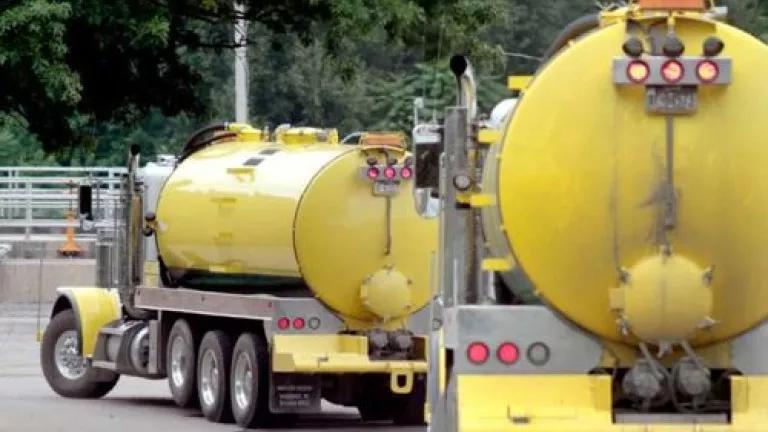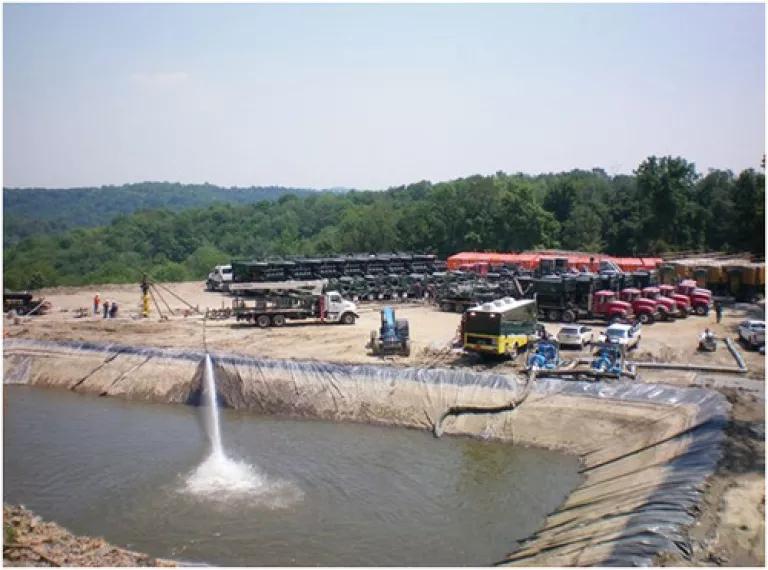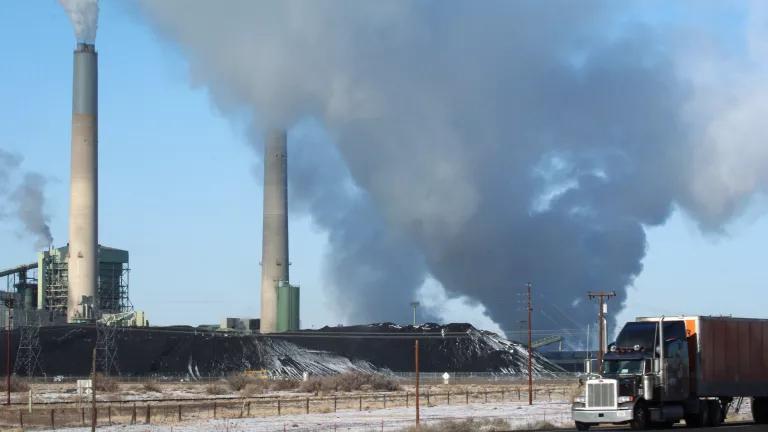
A new report released by NRDC today shows that contaminated fracking wastewater is threatening people’s health and the environment, and none of the methods currently used to treat or dispose of that wastewater are safe enough.
The process used to extract natural gas from underground shale formations, called hydraulic fracturing or “fracking,” creates potentially hazardous wastewater byproducts. These byproducts include the fracking fluid that returns to the surface of the natural gas well, along with water that’s released from inside the shale formation.
This wastewater contains things like salts, oil and grease, metals, radioactive material, and manmade fracking chemicals. These pollutants can be dangerous if they’re released into the environment or if people are exposed to them. They can be toxic to humans and aquatic life, radioactive, or corrosive. They can damage ecosystem health or interact with disinfectants at drinking water plants to form cancer-causing chemicals.
Yet, disturbingly, we’ve dumped this wastewater into our rivers and drinking water sources without removing harmful contaminants. We’ve spread it on icy roads, where it runs off into nearby waterways or seeps into groundwater. In fact, our report shows that none of the most common ways of dealing with this waste are currently safe for public health or the environment.
Specifically, right now there are a handful of management options being used to deal with this wastewater – none of which is currently being done safely enough:
- Treatment & discharge into surface waters - A lot of wastewater is sent to treatment plants and then discharged into water bodies. Usually this is done at a privately owned industrial wastewater treatment facility. Some of these private facilities are designed to remove the pollutants found in fracking waste, but many are not. Alternatively, in some regions, drillers have sent their wastewater to municipal sewage treatment plants, which aren’t designed to handle this stuff, and actually just dilute the pollutants rather than removing them. That’s a bad idea because when the wastewater is released into surface waters, contaminants can end up polluting local water bodies and drinking water sources. Consequently, treatment at municipal sewage treatment plants should be banned. Treatment at private industrial facilities faces significant safety hurdles that may be surmountable with improved safeguards (but it would still remain a less preferable disposal method for a number of reasons, such as the risks it would pose to people’s health in the event of a misstep). Treatment is also energy intensive and generates concentrated residual byproducts that have to be carefully dealt with.
- Spreading onto roads for ice or dust control - Since it’s so salty, some wastewater is repurposed for use as a road and highway deicing product in cold climates, or for dust control on rural dirt roads. This practice can be dangerous because it increases the risk that pollutants will leach into groundwater or be washed into nearby water bodies during rainstorms. As a result, road spreading should be banned.
- Disposal or storage in open pits - Some wastewater is stored in open pits (aka “impoundments”). Storage in open pits creates a risk of spills or leakage of wastewater into the ground, potentially contaminating soil, surface water, or groundwater. Additionally, impoundments cause large land disturbances and generate hazardous air pollution as the waste evaporates. As a result, impoundments should be banned.
- Underground injection - Fracking wastewater is often injected underground into disposal wells. When done with appropriate safeguards, this can be one of the safest options because it minimizes the risk of pollutants being released into the environment. However, current rules allow unsafe injection practices, which lead to a risk of groundwater contamination and earthquakes. With safeguards that ensure this waste is injected safely, this option for dealing with fracking wastewater could be more promising than others.
- Recycled for more fracking - Finally, some wastewater is recycled so that it can be pumped back underground for use in additional fracking. This can be a good thing, because it reduces the amount of freshwater that drillers need to use. But like other forms of treatment, it creates concentrated residuals and can be energy intensive. With rules that improve these downsides, this option could also be more promising than others. However, with current technologies, recycling is only an option for certain types of wastewater, so even if done safely it's only a partial solution to the wastewater management problem.

A fracking wastewater impoundment
National Energy Technology Laboratory
It’s clear that new or expanded fracking should not be allowed until we have better, safer solutions for dealing with the wastewater. Stronger safeguards are critical to help protect against the risks associated with this waste. NRDC’s new report describes many of the improvements that are needed, including the following:
- Closing loopholes in hazardous waste laws – Right now, because of a loophole in federal law, fracking wastewater doesn’t have to be handled as a hazardous waste even when it has hazardous characteristics. This means that fracking waste isn’t subject to the same treatment, storage, and disposal requirements as other hazardous wastes. This exemption from key safeguards puts our health and the environment at risk. Congress or the EPA should close this regulatory loophole immediately.
- Improving standards at treatment facilities – Standards for wastewater treatment facilities are extremely out-of-date and must be improved. For example, fracking waste should never be sent to municipal sewage treatment plants, and EPA or the states should ban this practice. Pollution limits also need to be updated for the private industrial plants that treat fracking waste.
- Banning road spreading – Spreading wastewater on roads should also be prohibited. Other deicing products are available that are equally effective but have less environmental impact – they should be used instead.
- Banning open pits of waste – The use of open impoundments to store wastewater should be prohibited. This waste should be collected at the well and either recycled or directly sent to disposal. If storage of wastewater is absolutely necessary, it should be done in closed tanks.
- Requiring safer underground injection – EPA should require that, whenever underground injection is used as a disposal method for fracking wastewater, hazardous waste disposal wells are used. These wells are subject to stricter rules to reduce earthquake and contamination risks than the oil and gas disposal wells currently used.
- Holding drillers accountable for where waste goes – Regardless of which treatment or disposal method a driller uses to manage its wastewater, all operators should be required to publicly disclose the final destination of the waste.
States (such as New York) that are considering authorizing fracking should not move forward until these safeguards are in place. Where fracking is already happening, the federal government and states must move forward swiftly to adopt this report’s policy recommendations to better protect people and the environment.
This is the second recent report from NRDC on fracking. In March, NRDC also released a report on reducing methane pollution in the natural gas production chain.




